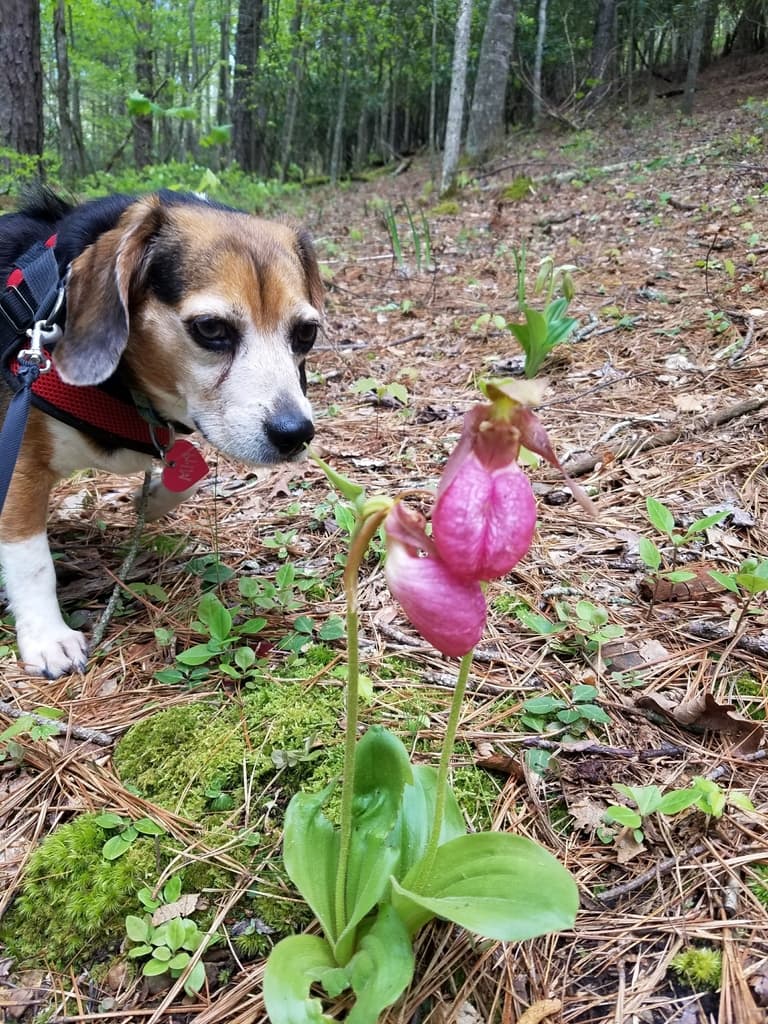Fellow iNatters!
Inspired by other ground-breaking scientific discoveries made possible through citizen science (seriously though - I love iNat’s monthly news highlights!), I’ve been bouncing some ideas off ChatGPT. Working closely with this cutting-edge high technology, I am pleased to report my own scientific breakthrough using the iNaturalist dataset!
The Photographic Evidence of Canine Influence on Pink Lady’s Slipper Orchid Distribution: A Visual Study

Abstract:
A peculiar pattern has emerged from a series of photographic observations suggesting that canine activity may be associated with the distribution and abundance of Pink Lady’s Slipper orchids (Cypripedium acaule). This study presents photographic evidence indicating that areas frequented by dogs exhibit a higher density of these orchids. We analyze the implications of these visual observations and propose potential mechanisms for this correlation based solely on photographic data.
Introduction:
Pink Lady’s Slipper orchids are distinguished by their striking appearance and have been extensively studied for their ecological and botanical significance. Recently, a series of photographs depicting various woodlands has revealed a curious trend: regions with visible canine presence seem to coincide with higher populations of Pink Lady’s Slipper orchids. This study explores these photographic findings and theorizes possible explanations for this correlation.
Materials and Methods:
Photographic evidence was collected from multiple woodlands where Pink Lady’s Slipper orchids are known to thrive. High-resolution images were categorized based on the presence of dogs and the density of orchids. Photographs were sourced from both amateur and professional photographers who frequented these areas. The analysis focused on images showing clear interactions between dogs and their environment, alongside the visible presence of orchids.
Results:
Photographic Correlation Analysis: A comparative review of images revealed that areas with frequent dog activity, such as trails and parks, exhibited a significantly higher presence of Pink Lady’s Slipper orchids. In some cases, photographs of dogs playing or resting in orchid-rich areas showed an increased density of these orchids in the immediate vicinity.
Discussion:
The visual evidence presented suggests a potential link between canine presence and the distribution of Pink Lady’s Slipper orchids. While the photographic data is circumstantial, it provides a basis for hypothesizing that dogs may influence orchid populations through activities that alter soil conditions or aid in seed dispersal. The observed correlation could be due to factors such as soil enrichment from canine activities or incidental seed transport by dogs.
Limitations:
It is important to acknowledge that the study is based solely on photographic evidence, which, while suggestive, does not provide conclusive proof of causation. Further empirical research involving controlled experiments and direct observations is necessary to validate these preliminary findings.
Conclusion:
This visual study offers intriguing insights into the potential role of dogs in the spread of Pink Lady’s Slipper orchids. The photographic evidence suggests a correlation that merits further investigation. Understanding the interplay between canine behavior and plant ecology could uncover new aspects of natural interactions and contribute to more comprehensive botanical studies.
Acknowledgments:
We thank the photographers and nature enthusiasts who contributed their images and observations, which provided the foundation for this study. Special thanks to the dogs and their owners who, through their everyday activities, inadvertently participated in this research.
I’m so thrilled to now be a published author! Who else has been sitting on some solid scientific discoveries?







